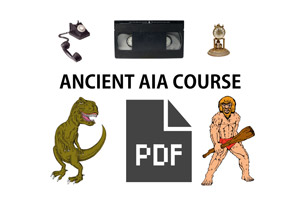How Your Outdated AIA Course is Affecting Your Brand
Does your AIA education course look like a train wreck? Are your product reps using Powerpoint presentations from 1999? Do architects fall asleep during your box lunch seminars? Then maybe its time to update your CE course. An antiquated AIA CE course can negatively affect your brand and open the door for your competition.
PDF Courses
If the primary delivery format for your AIA CE course is a PDF, you’re in trouble. The Portable Document Format or PDF, was developed in the early 1990’s as a way to share documents, including text formatting and images, among users of different computer platforms. Using a PDF or Microsoft Word Document as your primary delivery format is like reading a month old newspaper to gain knowledge today instead of using the internet. Users typically have to download the PDF and read the document like a newspaper article. PDF’s have their place in education but should only be used as an additional resource (white paper, case study, etc.) and not as the primary format for your AIA CE course.
There are several limitations when using a PDF as a delivery format for AIA education. Older PDFs may use media embedded in them that is not playable on architect’s devices. Rich Media PDF will not operate in Apple's iOS devices such as the iPad and interactivity is limited. PDF attachments carrying viruses were first discovered in 2001. The virus, named OUTLOOK.PDFWorm or Peachy, uses Microsoft Outlook to send itself as an attachment to an Adobe PDF file. Finally, the PDF is the equivalent of a printed page in machine reproducible form. It's one step up from a JPEG image. Interactivity and creativity is limited which means there are less tools to use to educate architects about your products. This is bad for your brand. Surprisingly, AIA education provider AEC Daily uses this outdated delivery format as their primary education tool.
Powerpoint Courses
Microsoft PowerPoint has been the primary tool for developing AIA CE courses for decades now. It has been the warhorse of tools but also the butt of many jokes. Death by Powerpoint is a nightmare no one wants to suffer. We have all endured bad Powerpoint presentations where the speaker reads his own slides, mountains of bullet points drown out crummy stock photos and clip art, and architects suffer from narcolepsy and fall out of their chairs.
Microsoft's version of PowerPoint was officially launched on May 22, 1990, as a part of the Microsoft Office suite. Its a quarter of a century old and in the wrong hands can inflict damage to your brand and specification chances. However, Powerpoint can still be a powerful tool if used correctly. The best Powerpoint presentations utilize video, animation, and voice over. Great Powerpoint presentations tell a story about a building product and aren’t just lame sales pitches by overeager product reps looking to close the deal. Powerpoint presentations with voice over work very well as online AIA courses when exported as MPEG4 files. These courses perform much better than all other formats except full video courses.
Video Courses
AIA courses in video format have the highest participation rates in the industry. If you want architects, specifiers, interior designers, and contractors to learn about your building product, there is no more effective method than video education. Video courses routinely outperform any other delivery format and justify their higher costs with better ROI. Architects want to learn about your building products but in an engaging and entertaining way.
Cisco, the networking equipment manufacturer, released a significant study on video education. This ground breaking research revealed several important benefits related to video education. Video allows architects to expand their understanding of complex subjects by strengthening the link between abstract ideas and practical applications. Video education also gives architects the opportunity to travel to remote locations to learn without ever leaving their office or home. Video is the ideal format for case studies, product installations, and education courses.
Research indicates that young professionals, such as architects and engineers, today are fundamentally different from previous generations in the way they think and in the way they access, absorb, interpret, process and use information. Today design professionals are increasingly visual-spatial learners, able to multitask and interact with multimedia.
Is your company using 21st century technology to effectively educate architects? Do you still use antiquated delivery formats like PDFs and Microsoft Docs? How will your company prepare for the future to educate design professionals?
For more information or to discuss the topic of this blog, please contact Brad Blank





